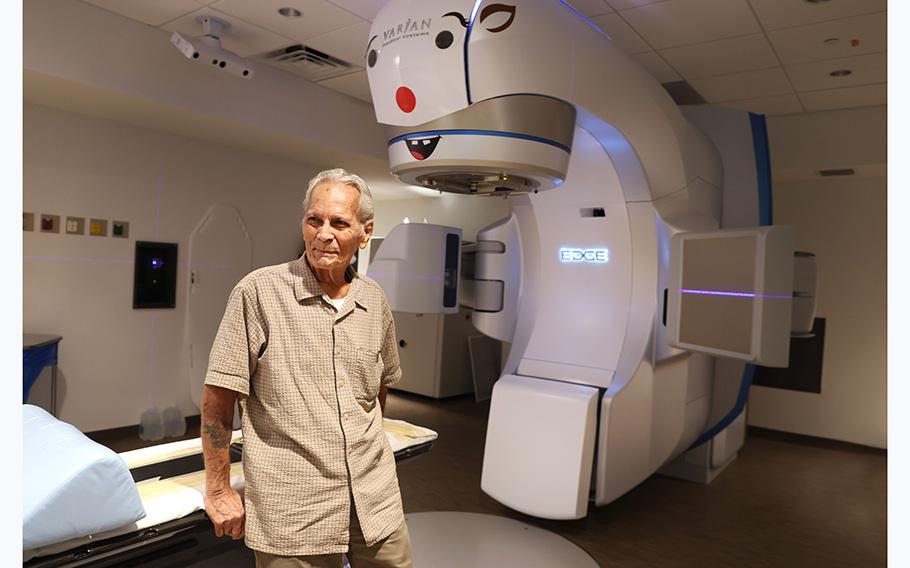
Louis Gomez, 94, of Delray Beach, near an x-ray radiation machine at the South Florida Proton Therapy Institute in Delray Beach on Tuesday, May 23, 2023. Gomez a cancer survivor and veteran believes he got cancer because of radiation exposure and beat it because of radiation therapy. (Carline Jean/South Florida Sun Sentinel)
(Tribune News Service) — A World War II veteran says he developed cancer because of radiation exposure while in the Navy. He beat it this year at the age of 94 with radiation therapy.
It’s an odd twist in fate for Louis Gomez, who became exposed to radiation while working on a destroyer ship during World War II.
Gomez says he participated in Operation Crossroads, a pair of nuclear weapon tests conducted by the United States at Bikini Atoll in the Marshall Islands in mid-1946. After the tests, he says the ship he was on had radioactive barnacles on the bottom that needed to be removed before he and the crew could disembark in San Francisco. He spent several months on the ship waiting for them to be removed.
A few years after Gomez ended his eight-year tour, he learned that because of the radiation exposure, he was sterile. He lost much of his hearing as well.
Now, decades later, he feels fortunate a giant photon machine that delivered radiation directly to a cancerous mass in his rectum saved his life.
Gomez discovered the tumor when he became so uncomfortable he could barely sit on a chair.
“I had to sit sideways,” he said.
After a few tests, doctors told Gomez the melon-size lump was cancerous.
They gave him a few options. Gomez refused surgery that would have required living with a colostomy bag, and took a high-tech route instead. He opted for “targeted radiation therapy.”
Six months after his rectal cancer diagnosis, the mass now is gone and Gomez is in the all clear.
“I feel terrific,” he said. “I’m a happy person.”
Using a giant machine at the South Florida Proton Therapy Institute in Delray Beach, radiation oncologists delivered precise doses of radiation to the tumor for 20 minutes a day. After five weeks of treatment, Gomez rang the brass bell outside the treatment room, signaling completion and success.
“The tumor melted before our very eyes,” said Dr. J.W. Snider, a radiation oncologist with the South Florida Proton Therapy Institute, across from and affiliated with Delray Medical Center. “He had an excellent response to therapy.”
A sales representative, he went on to get married, several times, and eventually divorced.
Gomez, who was born in Puerto Rico and spent most of his early life in New York, now lives on his own in Fort Lauderdale. He drives, enjoys telling accounts of his life adventures and war experiences, and befriends those who come into his path. He says this is his first time with any significant illness.
Dr. Snider says because of where the cancer was lodged, Gomez was a good candidate for photon therapy with the Varian Edge Linac machine. Snider calls the machine “the workhorse of the radiation field.”
“It allows us to do all the tricks that you can do with an X-ray machine,” Snider said. “It can do small targets at high doses but in a larger target like Mr. Gomez’s, it can also really paint the dose away from his normal, healthy tissues. Without this machine, the dose we needed to sterilize his tumor could have very much damaged his bowels and burned a hole in his bowels or his bladder and caused him to have long-term issues.”
Snider said the photon therapy machine is used to treat cancers such as prostate, lung, breast, head and neck, and is particularly good with small tumors. In a room next door, the center houses a proton therapy machine that works 300 times faster than traditional radiation and has extreme precision. The proton machine works well when the cancer is close to vital organs. The two machines are operated by three radiation oncologists at the center who spend long days treating cancer patients back-to-back.
“Radiation oncology has been around, but really, our technology and our machines have changed vastly in the last couple decades,” Snider said. “This has become an important portion of cancer care.”
Gomez said his only side effect was weight loss. He began treatment in March at 127 pounds and dropped to 123 just five weeks later. After his treatment ended on April 25th, he says his weight is back up to 131 pounds.
The doctor said Gomez is under observation, returning monthly, and will get comprehensive imaging in a few months to ensure the mass doesn’t return.
Over the last few months, doctors, nurses, even the office manager at the South Florida Proton Therapy Institute took a liking to Gomez, who regaled them with stories and jokes. Office Manager Ana Castro says her insurance coordinators worked tenaciously with the Veterans Administration to get them to pay for Gomez’s treatment.
“They spent about an hour on the phone with them,” said Castro, who is so taken with Gomez she recently took him out to brunch. “I come from a military family,” she said, adding that her brother, whose son in the Army was killed in Afghanistan, enjoyed meeting Gomez, too.
After showing visitors the machine that saved his life, Gomez walked out of the room with a broad smile and rang the brass bell again. “I’m very impressed and I’m very happy with the way I was taken care of, and I just couldn’t ask for anything more.”
©2023 South Florida Sun-Sentinel.
Visit sun-sentinel.com.
Distributed by Tribune Content Agency, LLC.